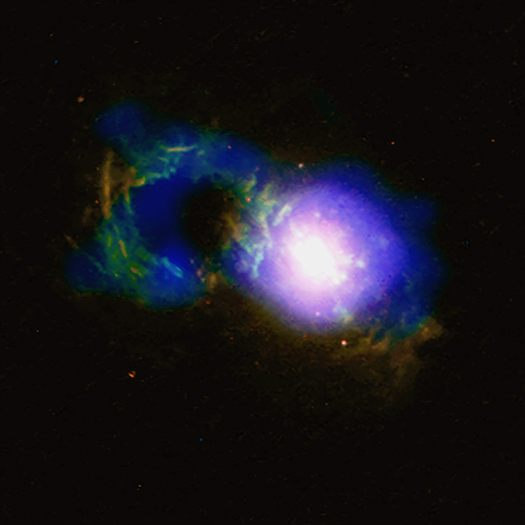
A quasar – nicknamed the Teacup because of its shape – is causing a storm in galaxy about 1.1 billon light-years from Earth. The power source of the quasar, astronomers say, is a supermassive black hole at the galaxy’s center.
A statement from the Chandra X-Ray Observatory explains:
As matter in the central regions of the galaxy is pulled toward the black hole, it is energized by the strong gravity and magnetic fields near the black hole. The infalling material produces more radiation than all the stars in the host galaxy. This kind of actively growing black hole is known as a quasar.
The Teacup’s host galaxy – officially known as SDSS 1430+1339 – was discovered in 2007. New data from Chandra and ESA’s XMM-Newton mission are giving astronomers an improved understanding of the history of this galactic storm. A study describing these results was published March 20, 2019, in The Astrophysical Journal Letters. Read more about what astronomers are learning about the Teacup from the Chandra X-Ray Observatory here.

This new composite image contains X-ray data from Chandra (blue) along with an optical view from NASA’s Hubble Space Telescope (red and green). The “handle” of the Teacup is a ring of optical and X-ray light surrounding a giant bubble. This handle-shaped feature, which is located about 30,000 light-years from the supermassive black hole, was likely formed by one or more eruptions powered by the black hole. Image via NASA/STScI/W. Keel et al.
Bottom line: A quasar nicknamed the Teacup is causing a storm in a distant galaxy.
Source: Storm in a Teacup: X-ray view of an obscured quasar and superbubble
from EarthSky https://ift.tt/2TX9wrJ

A quasar – nicknamed the Teacup because of its shape – is causing a storm in galaxy about 1.1 billon light-years from Earth. The power source of the quasar, astronomers say, is a supermassive black hole at the galaxy’s center.
A statement from the Chandra X-Ray Observatory explains:
As matter in the central regions of the galaxy is pulled toward the black hole, it is energized by the strong gravity and magnetic fields near the black hole. The infalling material produces more radiation than all the stars in the host galaxy. This kind of actively growing black hole is known as a quasar.
The Teacup’s host galaxy – officially known as SDSS 1430+1339 – was discovered in 2007. New data from Chandra and ESA’s XMM-Newton mission are giving astronomers an improved understanding of the history of this galactic storm. A study describing these results was published March 20, 2019, in The Astrophysical Journal Letters. Read more about what astronomers are learning about the Teacup from the Chandra X-Ray Observatory here.

This new composite image contains X-ray data from Chandra (blue) along with an optical view from NASA’s Hubble Space Telescope (red and green). The “handle” of the Teacup is a ring of optical and X-ray light surrounding a giant bubble. This handle-shaped feature, which is located about 30,000 light-years from the supermassive black hole, was likely formed by one or more eruptions powered by the black hole. Image via NASA/STScI/W. Keel et al.
Bottom line: A quasar nicknamed the Teacup is causing a storm in a distant galaxy.
Source: Storm in a Teacup: X-ray view of an obscured quasar and superbubble
from EarthSky https://ift.tt/2TX9wrJ

Aucun commentaire:
Enregistrer un commentaire